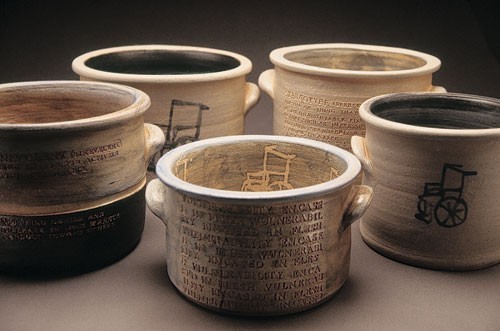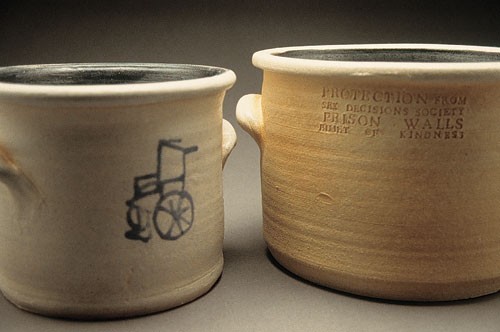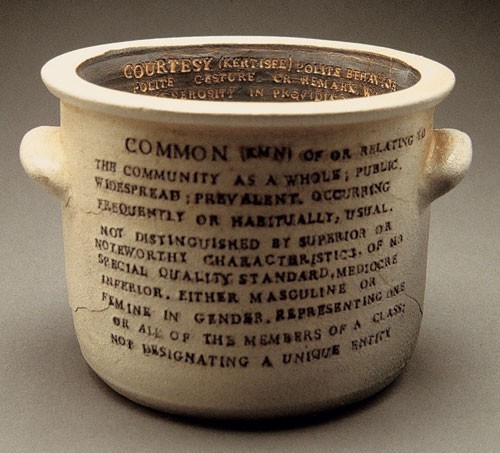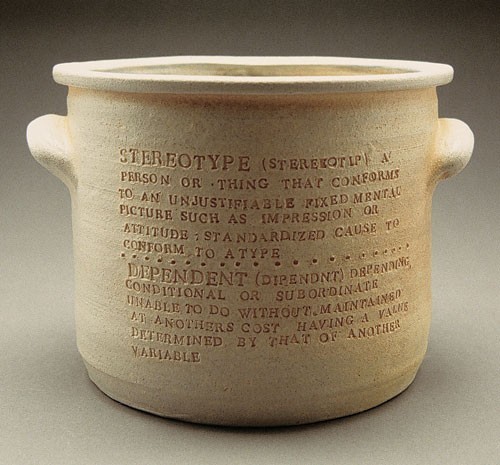
Lindsay Allington, Crock Series 2003. Soda-fired stoneware. H. of tallest 12". (All photos, Lindsay Allington.)

Lindsay Allington, Crock Series 2003. Soda-fired stoneware. H. of each approx. 12".

Lindsay Allington, Protection from Sex, Decisions, Society—Prison Walls Built of Kindness, 2003. Soda-fired stoneware. H. 12".

Lindsay Allington, Benevolent Kindness, 2003. Soda-fired stoneware. H. 12". Inscribed: “BENEVOLENT (BINEVELENT) WISHING TO DO GOOD ACTIVELY HELPFUL. CHARITABLE. / KIND (KIND) GENTLE AND CONSIDERATE IN ONES MANNER OR CONDUCT TOWARD OTHERS.”

Lindsay Allington, Common Courtesy, 2003. Soda-fired stoneware. H. 12". Inscribed: “COMMON (KMN) OF OR RELATING TO THE COMMUNITY AS WHOLE; PUBLIC. WIDESPREAD; PREVALENT, OCCURRING FREQUENTLY OR HABITUALLY; USUAL. / NOT DISTINGUISHED BY SUPERIOR OR NOTEWORTHY CHARACTERISTICS. OF NO SPECIAL QUALITY, STANDARD, MEDIOCRE, INFERIOR. EITHER MASCULINE OF FEMININE IN GENDER. REPRESENTING ONE OR ALL OF THE MEMBERS OF A CLASS; NOT DESIGNATING A UNIQUE ENTITY.”

Lindsay Allington, Stereotype Dependent, Stereotype Victim, 2003. Alkaline-glazed stoneware. H. 12". Inscribed: “STEREOTYPE (STEREOTIP) A PERSON OR THING THAT CONFORMS TO AN UNJUSTIFIABLE FIXED MENTAL PICTURE SUCH AS IMPRESSION OR ATTITUDE; STANDARDIZED CAUSE TO CONFORM TO A TYPE / DEPENDENT (DIPENDNT) DEPENDING, CONDITIONAL OR SUBORDINATE UNABLE TO DO WITHOUT. MAINTAINED AT ANOTHERS COST HAVING A VALUE DETERMINED BY THAT OF ANTOTHER VARIABLE.”
In my work as a potter I strive not only to forge ahead in the world of ceramics but also to look back and acknowledge the rich history of the craft. In Crock Series 2003 (fig. 1), I sought to emulate classic early American colonial pottery. I have long been fascinated by the simplicity, dignity, and grace of these finely crafted wares found in all areas of the United States—from the elegant cobalt slip design of the North to the earthy alkaline glazes of the South. The bowls, churns, crocks, pitchers, and many other objects formed from the potter’s local clay were necessities of the time. Today, with the many substitutes available, we do not need to speak so passionately about the need for ceramic wares. Likewise, time has proven some forms—specifically churns, crocks, and jugs—to be obsolete.
In my desire to reproduce these antique types, I found myself in a subconscious struggle about whether it was rational to produce forms that society deemed outmoded and no longer knew how to use. I wanted my work to foster a new appreciation for the forms of the past, and I believed this could be achieved in the decoration with stamping and slip design (fig. 2). In my crock series, I sought to take a form I love and give it a new, contemporary function as a catalyst for social commentary.
The inspiration for my work was a 2003 photography exhibition at Skidmore College in Saratoga Springs, New York, entitled “Beggars and Choosers: Motherhood Is Not a Privilege in America.” The works challenged social stereotypes and beliefs about welfare mothers in America and, in so doing, highlighted their basic needs and rights as humans and individuals. I felt moved by the passion of the photographers and enlightened by the plight of their subjects. Wanting my own work to have a similar depth and impact on the viewer, I chose a group I felt passionate about with regard to their rights and how they are viewed by society: the disabled.
This community, like many others, is subjected to stereotyping; as a result, the individual is often overlooked. People with disabilities suffer from generalizations imposed by society that at times can feel more crippling than their ailment and that are passed from one generation to the next. I chose the wheelchair to represent the disabled, in keeping with society’s perception of them (fig. 3). With the use of stamps, I broke down words associated with the disabled and used the definitions to provoke thought (figs. 4, 5).
I chose the crock form specifically because of its function as a vessel for preserving food and I gave it new purpose as a vessel for preserving ideas. The crock form serves as a metaphor for the stereotypes and myths about the disabled and how they are preserved in our culture (fig. 6).
Lindsay Allington, Stoneware Potter; lindsay_allington@yahoo.com
